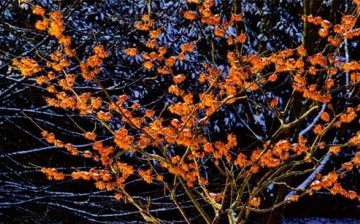Magic plant - witch hazel
The witch hazel plant differs from others not only in the original shape of its flowers, arachnoid shape, but also in the extreme flowering time. Snow lies on the branches of sleeping trees, and witch hazel lights up with the bright colors of its inflorescences. Witch hazel blooms, depending on the variety, either in early spring, before the leaves appear, or in late autumn, when most plants are already shedding their foliage in preparation for winter. This feature makes the witch hazel bush the most magical plant in the garden. Flowers of amazing shape, sunny yellow, orange or red colors are endowed with a wonderful aroma, instantly captivating any visitor to the garden. Such a bewitching sight lasts 15-20 days.
"Witch's Nut"
Besides the classic name, the witch hazel plant is often called "Witch's hazel" or "Witch's nut". It is not so much the medical properties inherent in the fruits and bark of this bush that make it magical, but the amazing timing of flowering and fruiting: in varieties with autumn flowering, the fruits ripen in the summer of next year.
Healing properties of witch hazel
The fruits of witch hazel are distinguished by a high content of essential oil, which is used in perfumery to care for oily skin, helps to tighten enlarged pores and prevents inflammation.
The branches and bark of witch hazel have astringent substances used in various tinctures and decoctions.
Witch hazel leaves contain a significant amount of flavonoids, as well as a specific group of substances - tannins. It is tannins that have an excellent antibacterial effect and help to strengthen the vascular walls and the outflow of fluid from large vessels, which is used in the prevention of varicose veins.




And how to brew and generally use witch hazel for insomnia? I was once told that such a remedy perfectly soothes and stabilizes blood pressure ...
Witch hazel has never been seen in nature, but in some cosmetic products for skin care, this name is found quite often.